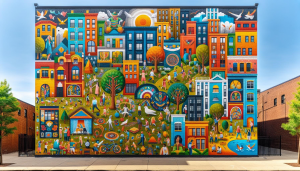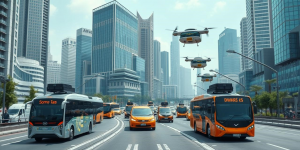Hey everyone! As an urban designer, I’ve learned one thing for sure: getting the community involved is everything. Too often, plans are made in fancy offices, totally disconnected from the people who will actually live with the results. This is a recipe for disaster – resentment, resistance, and projects that ultimately fail. But when you genuinely involve the community? That’s when the magic happens.
Seriously, effective community engagement isn’t just a “nice-to-have.” It’s a must. It makes sure that plans reflect the diverse viewpoints, values, and what’s truly important to the residents. This leads to communities that are more fair, sustainable, and, well, just plain better! Plus, it creates a sense of ownership and shared responsibility. People are more likely to support and take care of projects they feel invested in. And honestly, it makes my job – and every urban planner’s job – way easier.
Why Community Engagement Matters (Like, Really Matters)
Think about it this way: Who knows a neighborhood better than the people who live there? They get the local vibe, the hidden problems, and the awesome potential. Ignoring their input is like trying to build a house without, you know, a foundation! It might look good on paper, but it won’t last.
Community engagement also builds trust between residents and the local government. When people feel heard and respected, they’re way more likely to get behind public projects and participate in civic life. And that strengthens the whole community, making it more resilient and connected.

Best Practices: Let’s Get Real About Community Engagement
Okay, so how do you actually do community engagement well? It’s not just about holding a couple of public meetings and calling it a day. It takes a real commitment to listening, learning, and working together. Here are some of the best practices I’ve picked up over the years:
1. Start Early, Stay Engaged: Don’t Be a Stranger
Don’t wait until the plans are already set in stone to bring in the community. Start the conversation right at the beginning, when you’re still figuring things out and defining the problem. And don’t treat it like a one-time thing! Keep those lines of communication open throughout the whole planning process. Provide regular updates and make it easy for people to give feedback.
Real-World Example: In Detroit, we kicked off a project by hosting “kitchen table conversations” with residents. We literally met them in their homes, listened to their concerns, and heard their dreams for the neighborhood. This helped us build trust and develop a shared understanding of what needed to be done.
2. Know Your Audience: One Size Doesn’t Fit All
Every community is unique. What works in one neighborhood might totally flop in another. So, take the time to really understand the people you’re trying to reach. What are their demographics? What’s their culture like? How do they prefer to communicate? Are there any groups that are often overlooked? Tailor your approach to meet the specific needs of each community.
Real-World Example: In a diverse neighborhood with lots of immigrants, we partnered with local organizations to translate materials into multiple languages. We also offered childcare during meetings to make it easier for parents to participate. Small things make a big difference!
3. Mix It Up: Use a Variety of Engagement Methods
Don’t just rely on those traditional public meetings. Use a mix of online and offline methods to reach as many people as possible. Think about:
- Surveys and questionnaires: Great for getting feedback from a large group.
- Workshops and focus groups: Perfect for diving deep into specific issues and brainstorming solutions.
- Community events and festivals: Create a fun, informal setting to connect with people.
- Online forums and social media: Keep the conversation going and share information easily.
- Participatory budgeting: Let residents directly decide how public funds are spent. Talk about empowerment!
Real-World Example: When renovating a park, we used online surveys, public meetings, and even “pop-up” engagement events right in the park itself! This allowed us to connect with all kinds of users and get valuable feedback on what they wanted to see.
4. Transparency is Key: Be Open and Honest
Be upfront about the planning process, including the limitations and compromises involved. Share information in a clear, easy-to-understand way. Be quick to respond to questions and concerns. Explain how community feedback is shaping the plans, and be ready to explain why you’re making certain decisions.
Real-World Example: For a huge development project, we created a website that was constantly updated. We posted meeting minutes, presentations, and a summary of all the community feedback and how it was being used to shape the final design.
5. Empower Residents: Give Them the Tools They Need
Community engagement isn’t just about collecting information. It’s about giving residents the ability to actively participate in the planning process. Provide training and resources to help them understand the technical stuff and advocate for their needs effectively. Empower them to take ownership and become real agents of change in their communities.
Real-World Example: We teamed up with a local university to offer a free “citizen planning academy.” Residents got training in urban design principles, community organizing, and advocacy skills. Talk about leveling the playing field!
Tech to the Rescue? The Role of Technology
Technology can be a game-changer for community participation. Digital platforms and social media can reach a wider audience, make online discussions easier, and provide access to information and resources. But remember the digital divide! Make sure everyone has the opportunity to participate, regardless of their access to technology.
Real-World Example: We used an online mapping tool that allowed residents to pinpoint areas of concern and propose solutions on a digital map of their neighborhood. It was a visually engaging way to gather specific feedback and understand community priorities.
The Inevitable Challenges (and How to Tackle Them)
Let’s be real: community engagement isn’t always smooth sailing. You’re likely to run into challenges like:
- Apathy and disengagement: Some residents might feel like their voices don’t matter or that the process is too complicated.
- Conflicting interests: Different groups within the community might have competing priorities.
- Lack of resources: Engagement can be time-consuming and expensive.
- Distrust of government: Some residents might be skeptical of the motives of local officials.
To overcome these hurdles, you need to be patient, persistent, and adaptable. Build trust by being transparent and responsive. Find creative ways to engage people who are often left out. Partner with local organizations to tap into their existing relationships and expertise. And don’t be afraid to try new approaches and adjust your strategies as you go.
A Call to Action: Let’s Do This Right
Community engagement isn’t just something to check off a list. It’s a core principle of good urban planning. By following these best practices, you can create more inclusive, transparent, and collaborative planning processes that lead to communities that are more fair, sustainable, and full of life. So, let’s put people at the center of our plans and build a better future, together!
Alright, let’s get to work!


